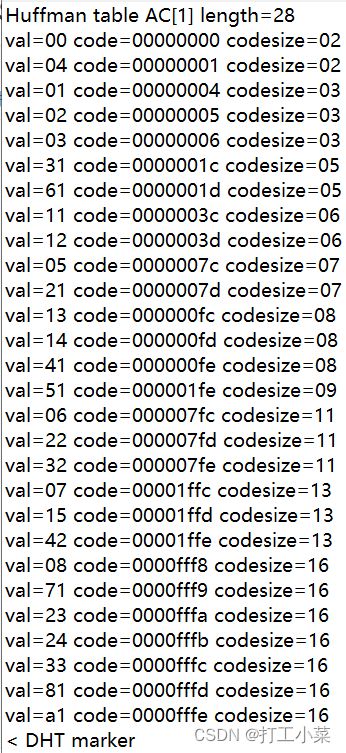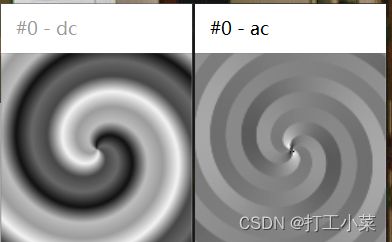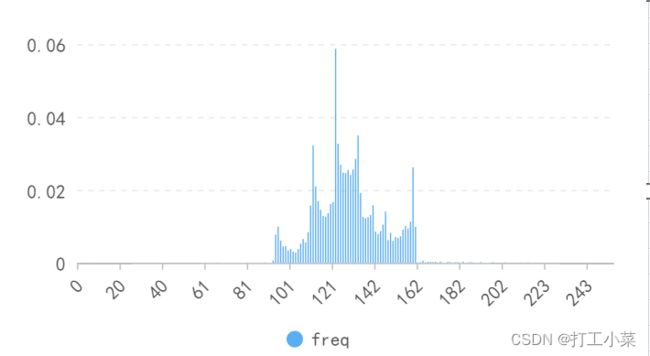JPEG原理分析及JPEG解码器的调试
实验原理
JPEG简介
JPEG的全称是JointPhotographicExpertsGroup(联合图像专家小组),它是一种常用的图像存储格式, jpg/jpeg是24位的图像文件格式,也是一种高效率的压缩格式,文件格式是JPEG(联合图像专家组)标准的产物,该标准由ISO与CCI TT(国际电报电话咨询委员会)共同制定,是面向连续色调静止图像的一种压缩标准。其最初目的是使用64Kbps的通信线路传输720×576 分辨率压缩后的图像。
JPEG的压缩,分为四个步骤:
(1)颜色转换:由于JPEG只支持YUV颜色模式,而不支持RGB颜色模式,所以在将彩色图像进行压缩之前,必须先对颜色模式进据转换。转换完成之后还需要进行数据采样。一般采用的采样比例是2:1:1或4:2:2。由于在执行了此项工作之后,每两行数据只保留一行,因此,采样后图像数据量将压缩为原来的一半。
(2)DCT变换:DCT(DiscreteConsineTransform)是将图像信号在频率域上进行变换,分离出高频和低频信息的处理过程。然后再对图像的高频部分(即图像细节)进行压缩,以达到压缩图像数据的目的。首先将图像划分为多个8*8的矩阵。然后对每一个矩阵作DCT变换(变换公式此略)。变换后得到一个频率系数矩阵,其中的频率系数都是浮点数。
(3)量化:由于在后面编码过程中使用的码本都是整数,因此需要对变换后的频率系数进行量化,将之转换为整数。由于进行数据量化后,矩阵中的数据都是近似值,和原始图像数据之间有了差异,这一差异是造成图像压缩后失真的主要原因。
(4)编码:编码采用两种机制:一是0值的行程长度编码;二是熵编码(EntropyCoding)。在JPEG中,采用曲徊序列,即以矩阵对角线的法线方向作“之”字排列矩阵中的元素。这样做的优点是使得靠近矩阵左上角、值比较大的元素排列在行程的前面,而行程的后面所排列的矩阵元素基本上为0值。行程长度编码是非常简单和常用的编码方式,在此不再赘述。编码实际上是一种基于统计特性的编码方法。在JPEG中允许采用HUFFMAN编码或者算术编码。
JPEG文件格式
- 均以 0xFF 开始,后跟 1 byte 的 Marker 和 2 byte 的 Segment length(包含表示 Length 本身所占用的 2 byte,不含“0xFF” + “Marker” 所占用的 2 byte);
- 采用 Motorola 序(相对于 Intel 序),即保存时高位在前,低位在后;
- Data 部分中,0xFF 后若为 0x00,则跳过此字节不予处理;
| 名称 | 含义 | 固定值 | 具体内容 |
| SOI(Start of Image) | 图像开始 | 0xFFD8 | |
| APP0(Application) | 应用程序保留标记0 | 0xFFE0 | 包含9个具体字段: |
| DQT(Define Quantization Table) | 定义量化表 | 0xFFDB | 包含9个具体字段: a) 精度及量化表ID 1字节 高4位:精度,只有两个可选值 0:8位;1:16位 b) 表项 (64×(精度+1))字节 例如8位精度的量化表,其表项长度为64×(0+1)=64字节 本标记段中,字段②可以重复出现,表示多个量化表,但最多只能出现4次 |
| SOF0(Start of Frame) | 帧图像开始 | 0xFFC0 | 包含9个具体字段: ④ 图像宽度 2字节 图像宽度(单位:像素) ⑤ 颜色分量数 1字节 只有3个数值可选 a)颜色分量ID 1字节 b)水平/垂直采样因子 1字节 高4位:水平采样因子 |
| DHT(Define Huffman Table) | 定义哈夫曼表 | 0xFFC4 | 包含2个具体字段: ① 数据长度 2字节 ② huffman表 数据长度-2字节 表ID和表类型 1字节 高4位:类型,只有两个值可选 0:DC直流;1:AC交流 低4位:哈夫曼表ID 注意,DC表和AC表分开编码 不同位数的码字数量 16字节 编码内容 16个不同位数的码字数量之和(字节) |
| SOS(Start of Scan) | 扫描开始 | 0xFFDA | 包含2个具体字段: ③颜色分量信息 高4位:直流分量使用的哈夫曼树编号 ④ 压缩图像数据 |
| EOI(End of Image) | 图像结束 | 0xFFD9 |
1.读取文件
2.解析 Segment Marker
2.1 解析 SOI
JPEG编解码原理
编码原理
1.零偏置(Level Offset)
对于灰度级是2n的像素,通过减去2n-1,将无符号的整数值变成有符号数
➢对于n=8,即将0~255的值域,通过减去128,转换为值域在-128~127之间的值
目的:使像素的绝对值出现3位10进制的概率大大减少
2.DCT变换
对每个单独的彩色图像分量,把整个分量图像分成8×8的图像块,如图所示,并作为两维离散余弦变换DCT的输入
3.量化
量化步距是按照系数所在的位置,颜色分量来确定
◼因为人眼对亮度信号比对色差信号更敏感,因此使用了两种量化表:亮度量化值和色差量化值
◼根据人眼的视觉特性(对低频敏感,对高频不太敏感)对低频分量采取较细的量化,对高频分量采取较粗的量化
➢如果原始图象中细节丰富,则去掉的数据较多,量化后的系数与量化前差别
➢反之,细节少的原始图象在压缩时去掉的数据少些
4.DC系数的差分编码
8×8的图像块经过DCT变换之后得到的DC直流系数有两个特点:系数的数值比较大;相邻8×8图像块的DC系数值变化不大(存在冗余),因此可以采用DPCM方法,对相邻图像块之间量化DC系数的差值进行编码,编码方式采用熵编码(Huffman编码),亮度信号与色度信号的DC系数采用不同的Huffman编码表
5.AC系数的zig-zag扫描与游程编码
由于经过DCT变换后,系数大多集中在左上角,也就是低频分量区,因此采用Z字形扫描,按频率的高低顺序读出,这样会出现很多的连零,可以使用RLE游程编码,尤其是在最后,如果都是零,直接给出EOB(End of Block)即可
·在JPEG编码中,游程编码的形式为:(run,level)
·表示连续run个0后有值为level的系数
·run最多15个,用4位表示RRRR
·level,类似DC,分成16个类别,用4位SSSS表示类别号,类内索引
·对(RRRR,SSSS)采用Huffman编码,对类内索引采用定长编码
·亮度信号和色度信号的AC系数也有不同的Huffman码表
解码原理
·解码Huffman数据
·解码DC差值
·重构量化后的系数
·DCT逆变换
·丢弃填充的行/列
·反0偏置
·对丢失的CbCr分量差值(下采样的逆过程)
·YCbCr →RGB
实验过程
实验要求
1.逐步调试JPEG解码器程序。将输入的JPG文件进行解码,将输出文件保存为可供YUVViewer观看的YUV文件。
2. 程序调试过程中,应做到:
- 理解程序设计的整体框架
- 理解三个结构体的设计目的
- struct huffman_table
- struct component
- struct jdec_private
- 理解在视音频编解码调试中TRACE的目的和含义
- 会打开和关闭TRACE
- 会根据自己的要求修改TRACE
3.以txt文件输出所有的量化矩阵和所有的HUFFMAN码表。
4.输出DC图像并统计其概率分布。
5.输出某一个AC值图像并统计其概率分布。
test.jpg yuv420p outyuv
代码分析
struct huffman_table
用来储存霍夫曼表
struct huffman_table
{
/* Fast look up table, using HUFFMAN_HASH_NBITS bits we can have directly the symbol,
* if the symbol is <0, then we need to look into the tree table */
short int lookup[HUFFMAN_HASH_SIZE];
/* code size: give the number of bits of a symbol is encoded */
unsigned char code_size[HUFFMAN_HASH_SIZE];
/* some place to store value that is not encoded in the lookup table
* FIXME: Calculate if 256 value is enough to store all values
*/
uint16_t slowtable[16-HUFFMAN_HASH_NBITS][256];
};struct component
存储当前像块中关于解码的信息
struct component
{
unsigned int Hfactor;
unsigned int Vfactor;
float *Q_table; /* Pointer to the quantisation table to use */
struct huffman_table *AC_table;
struct huffman_table *DC_table;
short int previous_DC; /* Previous DC coefficient */
short int DCT[64]; /* DCT coef */
#if SANITY_CHECK
unsigned int cid;
#endif
};struct jdec_private
存储图像宽高、码表等信息
struct jdec_private
{
/* Public variables */
uint8_t *components[COMPONENTS];
unsigned int width, height; /* Size of the image */
unsigned int flags;
/* Private variables */
const unsigned char *stream_begin, *stream_end;
unsigned int stream_length;
const unsigned char *stream; /* Pointer to the current stream */
unsigned int reservoir, nbits_in_reservoir;
struct component component_infos[COMPONENTS];
float Q_tables[COMPONENTS][64]; /* quantization tables */
struct huffman_table HTDC[HUFFMAN_TABLES]; /* DC huffman tables */
struct huffman_table HTAC[HUFFMAN_TABLES]; /* AC huffman tables */
int default_huffman_table_initialized;
int restart_interval;
int restarts_to_go; /* MCUs left in this restart interval */
int last_rst_marker_seen; /* Rst marker is incremented each time */
/* Temp space used after the IDCT to store each components */
uint8_t Y[64*4], Cr[64], Cb[64];
jmp_buf jump_state;
/* Internal Pointer use for colorspace conversion, do not modify it !!! */
uint8_t *plane[COMPONENTS];
};main
int main(int argc, char *argv[])
{
int output_format = TINYJPEG_FMT_YUV420P;
char *output_filename, *input_filename;
clock_t start_time, finish_time;
unsigned int duration;
int current_argument;
int benchmark_mode = 0;
#if TRACE
p_trace=fopen(TRACEFILE,"w");
if (p_trace==NULL)
{
printf("trace file open error!");
}
#endif
if (argc < 3)
usage();
current_argument = 1;
while (1)
{
if (strcmp(argv[current_argument], "--benchmark")==0)
benchmark_mode = 1;
else
break;
current_argument++;
}
if (argc < current_argument+2)
usage();
input_filename = argv[current_argument];//选择输出文件的格式
if (strcmp(argv[current_argument+1],"yuv420p")==0)
output_format = TINYJPEG_FMT_YUV420P;
else if (strcmp(argv[current_argument+1],"rgb24")==0)
output_format = TINYJPEG_FMT_RGB24;
else if (strcmp(argv[current_argument+1],"bgr24")==0)
output_format = TINYJPEG_FMT_BGR24;
else if (strcmp(argv[current_argument+1],"grey")==0)
output_format = TINYJPEG_FMT_GREY;
else
exitmessage("Bad format: need to be one of yuv420p, rgb24, bgr24, grey\n");
output_filename = argv[current_argument+2];
start_time = clock();
if (benchmark_mode)
load_multiple_times(input_filename, output_filename, output_format);
else
convert_one_image(input_filename, output_filename, output_format);
finish_time = clock();
duration = finish_time - start_time;
snprintf(error_string, sizeof(error_string),"Decoding finished in %u ticks\n", duration);
#if TRACE
fclose(p_trace);
#endif
return 0;
}
解码
int convert_one_image(const char *infilename, const char *outfilename, int output_format)
{
FILE *fp;
unsigned int length_of_file;
unsigned int width, height;
unsigned char *buf;
struct jdec_private *jdec;
unsigned char *components[3];
/* Load the Jpeg into memory */
fp = fopen(infilename, "rb");
if (fp == NULL)
exitmessage("Cannot open filename\n");
length_of_file = filesize(fp);
buf = (unsigned char *)malloc(length_of_file + 4);
if (buf == NULL)
exitmessage("Not enough memory for loading file\n");
fread(buf, length_of_file, 1, fp);
fclose(fp);
/* Decompress it */
jdec = tinyjpeg_init();
if (jdec == NULL)
exitmessage("Not enough memory to alloc the structure need for decompressing\n");
if (tinyjpeg_parse_header(jdec, buf, length_of_file)<0)
exitmessage(tinyjpeg_get_errorstring(jdec));
/* Get the size of the image */
tinyjpeg_get_size(jdec, &width, &height);
snprintf(error_string, sizeof(error_string),"Decoding JPEG image...\n");
if (tinyjpeg_decode(jdec, output_format) < 0)
exitmessage(tinyjpeg_get_errorstring(jdec));
/*
* Get address for each plane (not only max 3 planes is supported), and
* depending of the output mode, only some components will be filled
* RGB: 1 plane, YUV420P: 3 planes, GREY: 1 plane
*/
tinyjpeg_get_components(jdec, components);
/* Save it */
switch (output_format)
{
case TINYJPEG_FMT_RGB24:
case TINYJPEG_FMT_BGR24:
write_tga(outfilename, output_format, width, height, components);
break;
case TINYJPEG_FMT_YUV420P:
write_yuv(outfilename, width, height, components);
break;
case TINYJPEG_FMT_GREY:
write_pgm(outfilename, width, height, components);
break;
}
/* Only called this if the buffers were allocated by tinyjpeg_decode() */
tinyjpeg_free(jdec);
/* else called just free(jdec); */
free(buf);
return 0;
}
tinyjpeg_init
struct jdec_private *tinyjpeg_init(void)
{
struct jdec_private *priv;
priv = (struct jdec_private *)calloc(1, sizeof(struct jdec_private));
if (priv == NULL)
return NULL;
return priv;
}
tinyjpeg_parse_header
int tinyjpeg_parse_header(struct jdec_private *priv, const unsigned char *buf, unsigned int size)
{
int ret;
/* Identify the file */
if ((buf[0] != 0xFF) || (buf[1] != SOI)) //判断是否是jpeg文件
snprintf(error_string, sizeof(error_string),"Not a JPG file ?\n");
priv->stream_begin = buf+2;
priv->stream_length = size-2;
priv->stream_end = priv->stream_begin + priv->stream_length;
ret = parse_JFIF(priv, priv->stream_begin);
return ret;
}
parse_DQT
解码量化表
static int parse_DQT(struct jdec_private *priv, const unsigned char *stream)
{
int qi;
float *table;
const unsigned char *dqt_block_end;
#if TRACE
fprintf(p_trace,"> DQT marker\n");
fflush(p_trace);
#endif
dqt_block_end = stream + be16_to_cpu(stream);
stream += 2; /* Skip length */
while (stream < dqt_block_end)
{
qi = *stream++;
#if SANITY_CHECK
if (qi>>4)
snprintf(error_string, sizeof(error_string),"16 bits quantization table is not supported\n");
if (qi>4)
snprintf(error_string, sizeof(error_string),"No more 4 quantization table is supported (got %d)\n", qi);
#endif
table = priv->Q_tables[qi];
build_quantization_table(table, stream);
stream += 64;
}
#if TRACE
fprintf(p_trace,"< DQT marker\n");
fflush(p_trace);
#endif
return 0;
}parse_DHT
解码Huffman码表,并同时将Huffman码表写入trace文件
static int parse_DHT(struct jdec_private *priv, const unsigned char *stream)
{
unsigned int count, i;
unsigned char huff_bits[17];
int length, index;
length = be16_to_cpu(stream) - 2;
stream += 2; /* Skip length */
#if TRACE
fprintf(p_trace,"> DHT marker (length=%d)\n", length);
fflush(p_trace);
#endif
while (length>0) {
index = *stream++;
/* We need to calculate the number of bytes 'vals' will takes */
huff_bits[0] = 0;
count = 0;
for (i=1; i<17; i++) {
huff_bits[i] = *stream++;
count += huff_bits[i];
}
#if SANITY_CHECK
if (count >= HUFFMAN_BITS_SIZE)
snprintf(error_string, sizeof(error_string),"No more than %d bytes is allowed to describe a huffman table", HUFFMAN_BITS_SIZE);
if ( (index &0xf) >= HUFFMAN_TABLES)
snprintf(error_string, sizeof(error_string),"No more than %d Huffman tables is supported (got %d)\n", HUFFMAN_TABLES, index&0xf);
#if TRACE
fprintf(p_trace,"Huffman table %s[%d] length=%d\n", (index&0xf0)?"AC":"DC", index&0xf, count);
fflush(p_trace);
#endif
#endif
if (index & 0xf0 )
build_huffman_table(huff_bits, stream, &priv->HTAC[index&0xf]);
else
build_huffman_table(huff_bits, stream, &priv->HTDC[index&0xf]);
length -= 1;
length -= 16;
length -= count;
stream += count;
}
#if TRACE
fprintf(p_trace,"< DHT marker\n");
fflush(p_trace);
#endif
return 0;
}
tinyjpeg_decode
以mcu为单位进行解码
int tinyjpeg_decode(struct jdec_private *priv, int pixfmt)
{
unsigned int x, y, xstride_by_mcu, ystride_by_mcu;
unsigned int bytes_per_blocklines[3], bytes_per_mcu[3];
decode_MCU_fct decode_MCU;
const decode_MCU_fct *decode_mcu_table;
const convert_colorspace_fct *colorspace_array_conv;
convert_colorspace_fct convert_to_pixfmt;
if (setjmp(priv->jump_state))
return -1;
/* To keep gcc happy initialize some array */
bytes_per_mcu[1] = 0;
bytes_per_mcu[2] = 0;
bytes_per_blocklines[1] = 0;
bytes_per_blocklines[2] = 0;
decode_mcu_table = decode_mcu_3comp_table;
switch (pixfmt) {
case TINYJPEG_FMT_YUV420P:
colorspace_array_conv = convert_colorspace_yuv420p;
if (priv->components[0] == NULL)
priv->components[0] = (uint8_t *)malloc(priv->width * priv->height);
if (priv->components[1] == NULL)
priv->components[1] = (uint8_t *)malloc(priv->width * priv->height/4);
if (priv->components[2] == NULL)
priv->components[2] = (uint8_t *)malloc(priv->width * priv->height/4);
bytes_per_blocklines[0] = priv->width;
bytes_per_blocklines[1] = priv->width/4;
bytes_per_blocklines[2] = priv->width/4;
bytes_per_mcu[0] = 8;
bytes_per_mcu[1] = 4;
bytes_per_mcu[2] = 4;
break;
case TINYJPEG_FMT_RGB24:
colorspace_array_conv = convert_colorspace_rgb24;
if (priv->components[0] == NULL)
priv->components[0] = (uint8_t *)malloc(priv->width * priv->height * 3);
bytes_per_blocklines[0] = priv->width * 3;
bytes_per_mcu[0] = 3*8;
break;
case TINYJPEG_FMT_BGR24:
colorspace_array_conv = convert_colorspace_bgr24;
if (priv->components[0] == NULL)
priv->components[0] = (uint8_t *)malloc(priv->width * priv->height * 3);
bytes_per_blocklines[0] = priv->width * 3;
bytes_per_mcu[0] = 3*8;
break;
case TINYJPEG_FMT_GREY:
decode_mcu_table = decode_mcu_1comp_table;
colorspace_array_conv = convert_colorspace_grey;
if (priv->components[0] == NULL)
priv->components[0] = (uint8_t *)malloc(priv->width * priv->height);
bytes_per_blocklines[0] = priv->width;
bytes_per_mcu[0] = 8;
break;
default:
#if TRACE
fprintf(p_trace,"Bad pixel format\n");
fflush(p_trace);
#endif
return -1;
}
xstride_by_mcu = ystride_by_mcu = 8;
if ((priv->component_infos[cY].Hfactor | priv->component_infos[cY].Vfactor) == 1) {
decode_MCU = decode_mcu_table[0];
convert_to_pixfmt = colorspace_array_conv[0];
#if TRACE
fprintf(p_trace,"Use decode 1x1 sampling\n");
fflush(p_trace);
#endif
} else if (priv->component_infos[cY].Hfactor == 1) {
decode_MCU = decode_mcu_table[1];
convert_to_pixfmt = colorspace_array_conv[1];
ystride_by_mcu = 16;
#if TRACE
fprintf(p_trace,"Use decode 1x2 sampling (not supported)\n");
fflush(p_trace);
#endif
} else if (priv->component_infos[cY].Vfactor == 2) {
decode_MCU = decode_mcu_table[3];
convert_to_pixfmt = colorspace_array_conv[3];
xstride_by_mcu = 16;
ystride_by_mcu = 16;
#if TRACE
fprintf(p_trace,"Use decode 2x2 sampling\n");
fflush(p_trace);
#endif
} else {
decode_MCU = decode_mcu_table[2];
convert_to_pixfmt = colorspace_array_conv[2];
xstride_by_mcu = 16;
#if TRACE
fprintf(p_trace,"Use decode 2x1 sampling\n");
fflush(p_trace);
#endif
}
resync(priv);
/* Don't forget to that block can be either 8 or 16 lines */
bytes_per_blocklines[0] *= ystride_by_mcu;
bytes_per_blocklines[1] *= ystride_by_mcu;
bytes_per_blocklines[2] *= ystride_by_mcu;
bytes_per_mcu[0] *= xstride_by_mcu/8;
bytes_per_mcu[1] *= xstride_by_mcu/8;
bytes_per_mcu[2] *= xstride_by_mcu/8;
/* Just the decode the image by macroblock (size is 8x8, 8x16, or 16x16) */
for (y=0; y < priv->height/ystride_by_mcu; y++)
{
//trace("Decoding row %d\n", y);
priv->plane[0] = priv->components[0] + (y * bytes_per_blocklines[0]);
priv->plane[1] = priv->components[1] + (y * bytes_per_blocklines[1]);
priv->plane[2] = priv->components[2] + (y * bytes_per_blocklines[2]);
for (x=0; x < priv->width; x+=xstride_by_mcu)
{
decode_MCU(priv);
convert_to_pixfmt(priv);
priv->plane[0] += bytes_per_mcu[0];
priv->plane[1] += bytes_per_mcu[1];
priv->plane[2] += bytes_per_mcu[2];
if (priv->restarts_to_go>0)
{
priv->restarts_to_go--;
if (priv->restarts_to_go == 0)
{
priv->stream -= (priv->nbits_in_reservoir/8);
resync(priv);
if (find_next_rst_marker(priv) < 0)
return -1;
}
}
}
}
#if TRACE
fprintf(p_trace,"Input file size: %d\n", priv->stream_length+2);
fprintf(p_trace,"Input bytes actually read: %d\n", priv->stream - priv->stream_begin + 2);
fflush(p_trace);
#endif
return 0;
}TRACE
在音视频编解码中,TRACE是很关键的,它会随时将解码的相关信息写入文件,在后面可以通过查阅TRACE写的文件来理解解码到的信息分别都是什么或判断是否正确解码。
#define TRACE 1//add by nxn
#define TRACEFILE "trace_jpeg.txt"//add by nxn
#if TRACE //设定trace,边解码边写入文件
#endif
写入YUV文件
static void write_yuv(const char *filename, int width, int height, unsigned char **components)
{
FILE *F;
char temp[1024];
snprintf(temp, 1024, "%s.Y", filename);
F = fopen(temp, "wb");
fwrite(components[0], width, height, F);
fclose(F);
snprintf(temp, 1024, "%s.U", filename);
F = fopen(temp, "wb");
fwrite(components[1], width*height/4, 1, F);
fclose(F);
snprintf(temp, 1024, "%s.V", filename);
F = fopen(temp, "wb");
fwrite(components[2], width*height/4, 1, F);
fclose(F);
printf("write yuv begin!\n");
//yuv都写入一个文件
snprintf(temp, 1024, "%s.yuv", filename);
F = fopen(temp, "wb");
fwrite(components[0], width, height, F); //写Y
fwrite(components[1], width * height / 4, 1, F);
fwrite(components[2], width * height / 4, 1, F); //写UV
fclose(F); //关闭文件
printf("write yuv done!\n");
}
量化矩阵
static void build_quantization_table(float *qtable, const unsigned char *ref_table)
{
/* Taken from libjpeg. Copyright Independent JPEG Group's LLM idct.
* For float AA&N IDCT method, divisors are equal to quantization
* coefficients scaled by scalefactor[row]*scalefactor[col], where
* scalefactor[0] = 1
* scalefactor[k] = cos(k*PI/16) * sqrt(2) for k=1..7
* We apply a further scale factor of 8.
* What's actually stored is 1/divisor so that the inner loop can
* use a multiplication rather than a division.
*/
int i, j;
static const double aanscalefactor[8] = {
1.0, 1.387039845, 1.306562965, 1.175875602,
1.0, 0.785694958, 0.541196100, 0.275899379
};
const unsigned char *zz = zigzag;
const unsigned char* zz_2 = zigzag;
for (i=0; i<8; i++) {
for (j=0; j<8; j++) {
*qtable++ = ref_table[*zz++] * aanscalefactor[i] * aanscalefactor[j];
}
}
#if TRACE
for (i = 0; i < 8; i++)
{
for (j = 0; j < 8; j++)
{
fprintf(p_trace, "%-6d", ref_table[*zz_2++]);
}
fprintf(p_trace, "\n");
}
#endif
}霍夫曼码表
直流系数
交流系数
输出DC图像并统计其概率分布
每个8*8块解码后的DCT[0]即DC系数
更改后的 tinyjpeg_decode。
int tinyjpeg_decode(struct jdec_private *priv, int pixfmt)
{
unsigned int x, y, xstride_by_mcu, ystride_by_mcu;
unsigned int bytes_per_blocklines[3], bytes_per_mcu[3];
decode_MCU_fct decode_MCU;
const decode_MCU_fct *decode_mcu_table;
const convert_colorspace_fct *colorspace_array_conv;
convert_colorspace_fct convert_to_pixfmt;
unsigned char* DCbuf, * ACbuf;
unsigned char* uvbuf = 128;
int count = 0;
if (setjmp(priv->jump_state))
return -1;
/* To keep gcc happy initialize some array */
bytes_per_mcu[1] = 0;
bytes_per_mcu[2] = 0;
bytes_per_blocklines[1] = 0;
bytes_per_blocklines[2] = 0;
decode_mcu_table = decode_mcu_3comp_table;
switch (pixfmt) {
case TINYJPEG_FMT_YUV420P:
colorspace_array_conv = convert_colorspace_yuv420p;
if (priv->components[0] == NULL)
priv->components[0] = (uint8_t *)malloc(priv->width * priv->height);
if (priv->components[1] == NULL)
priv->components[1] = (uint8_t *)malloc(priv->width * priv->height/4);
if (priv->components[2] == NULL)
priv->components[2] = (uint8_t *)malloc(priv->width * priv->height/4);
bytes_per_blocklines[0] = priv->width;
bytes_per_blocklines[1] = priv->width/4;
bytes_per_blocklines[2] = priv->width/4;
bytes_per_mcu[0] = 8;
bytes_per_mcu[1] = 4;
bytes_per_mcu[2] = 4;
break;
case TINYJPEG_FMT_RGB24:
colorspace_array_conv = convert_colorspace_rgb24;
if (priv->components[0] == NULL)
priv->components[0] = (uint8_t *)malloc(priv->width * priv->height * 3);
bytes_per_blocklines[0] = priv->width * 3;
bytes_per_mcu[0] = 3*8;
break;
case TINYJPEG_FMT_BGR24:
colorspace_array_conv = convert_colorspace_bgr24;
if (priv->components[0] == NULL)
priv->components[0] = (uint8_t *)malloc(priv->width * priv->height * 3);
bytes_per_blocklines[0] = priv->width * 3;
bytes_per_mcu[0] = 3*8;
break;
case TINYJPEG_FMT_GREY:
decode_mcu_table = decode_mcu_1comp_table;
colorspace_array_conv = convert_colorspace_grey;
if (priv->components[0] == NULL)
priv->components[0] = (uint8_t *)malloc(priv->width * priv->height);
bytes_per_blocklines[0] = priv->width;
bytes_per_mcu[0] = 8;
break;
default:
#if TRACE
fprintf(p_trace,"Bad pixel format\n");
fflush(p_trace);
#endif
return -1;
}
xstride_by_mcu = ystride_by_mcu = 8;
if ((priv->component_infos[cY].Hfactor | priv->component_infos[cY].Vfactor) == 1) {
decode_MCU = decode_mcu_table[0];
convert_to_pixfmt = colorspace_array_conv[0];
#if TRACE
fprintf(p_trace,"Use decode 1x1 sampling\n");
fflush(p_trace);
#endif
} else if (priv->component_infos[cY].Hfactor == 1) {
decode_MCU = decode_mcu_table[1];
convert_to_pixfmt = colorspace_array_conv[1];
ystride_by_mcu = 16;
#if TRACE
fprintf(p_trace,"Use decode 1x2 sampling (not supported)\n");
fflush(p_trace);
#endif
} else if (priv->component_infos[cY].Vfactor == 2) {
decode_MCU = decode_mcu_table[3];
convert_to_pixfmt = colorspace_array_conv[3];
xstride_by_mcu = 16;
ystride_by_mcu = 16;
#if TRACE
fprintf(p_trace,"Use decode 2x2 sampling\n");
fflush(p_trace);
#endif
} else {
decode_MCU = decode_mcu_table[2];
convert_to_pixfmt = colorspace_array_conv[2];
xstride_by_mcu = 16;
#if TRACE
fprintf(p_trace,"Use decode 2x1 sampling\n");
fflush(p_trace);
#endif
}
resync(priv);
/* Don't forget to that block can be either 8 or 16 lines */
bytes_per_blocklines[0] *= ystride_by_mcu;
bytes_per_blocklines[1] *= ystride_by_mcu;
bytes_per_blocklines[2] *= ystride_by_mcu;
bytes_per_mcu[0] *= xstride_by_mcu/8;
bytes_per_mcu[1] *= xstride_by_mcu/8;
bytes_per_mcu[2] *= xstride_by_mcu/8;
/* Just the decode the image by macroblock (size is 8x8, 8x16, or 16x16) */
for (y=0; y < priv->height/ystride_by_mcu; y++)
{
//trace("Decoding row %d\n", y);
priv->plane[0] = priv->components[0] + (y * bytes_per_blocklines[0]);
priv->plane[1] = priv->components[1] + (y * bytes_per_blocklines[1]);
priv->plane[2] = priv->components[2] + (y * bytes_per_blocklines[2]);
for (x=0; x < priv->width; x+=xstride_by_mcu)
{
decode_MCU(priv);
DCbuf = (unsigned char)((priv->component_infos->DCT[0] + 512.0) / 4 + 0.5);
ACbuf = (unsigned char)(priv->component_infos->DCT[1] + 128);
fwrite(&DCbuf, 1, 1, DCfile);
fwrite(&ACbuf, 1, 1, ACfile);
count++;
convert_to_pixfmt(priv);
priv->plane[0] += bytes_per_mcu[0];
priv->plane[1] += bytes_per_mcu[1];
priv->plane[2] += bytes_per_mcu[2];
if (priv->restarts_to_go>0)
{
priv->restarts_to_go--;
if (priv->restarts_to_go == 0)
{
priv->stream -= (priv->nbits_in_reservoir/8);
resync(priv);
if (find_next_rst_marker(priv) < 0)
return -1;
}
}
}
}
#if TRACE
fprintf(p_trace,"Input file size: %d\n", priv->stream_length+2);
fprintf(p_trace,"Input bytes actually read: %d\n", priv->stream - priv->stream_begin + 2);
fflush(p_trace);
#endif
for (int j = 0; j < count * 0.25 * 2; j++)
{
fwrite(&uvbuf, sizeof(unsigned char), 1, DCfile);
fwrite(&uvbuf, sizeof(unsigned char), 1, ACfile);
}
return 0;
}计算概率分布
直流系数













